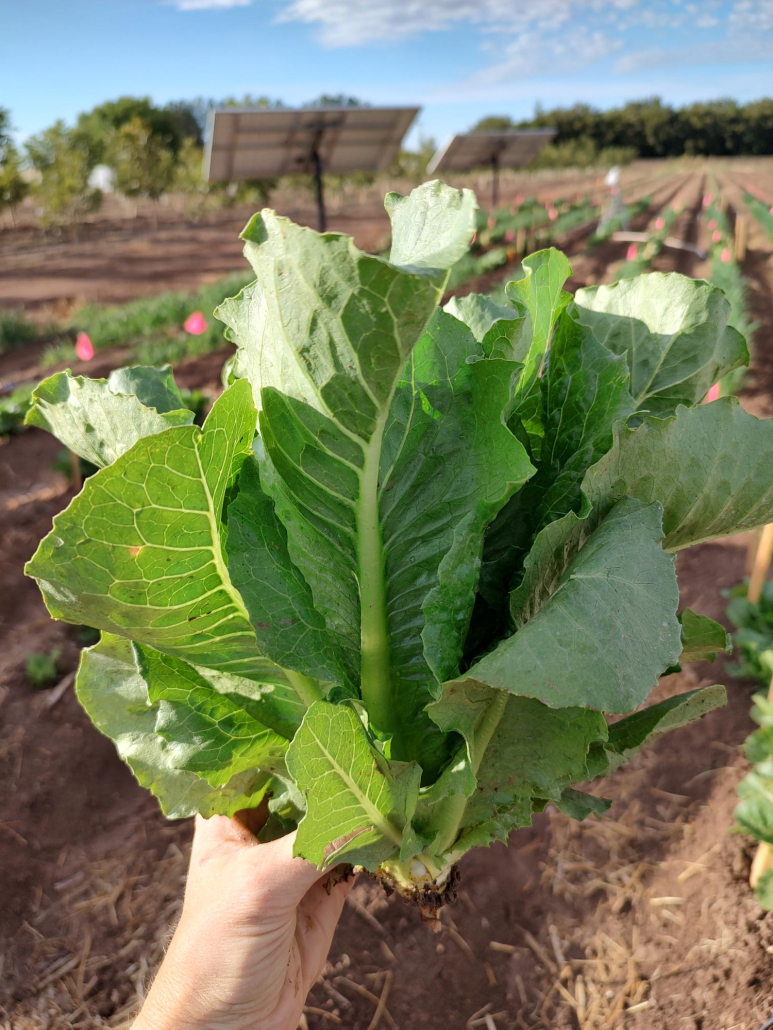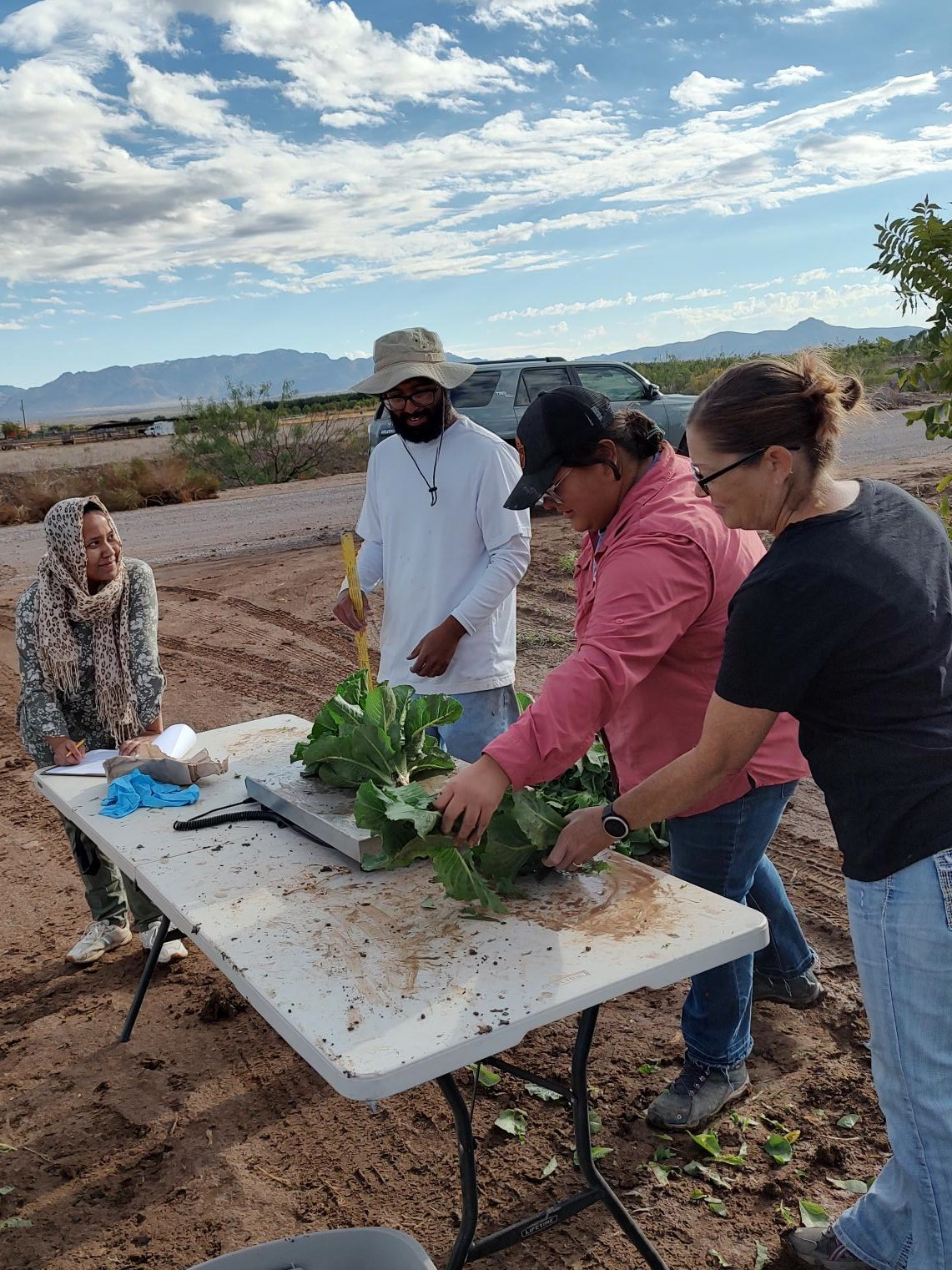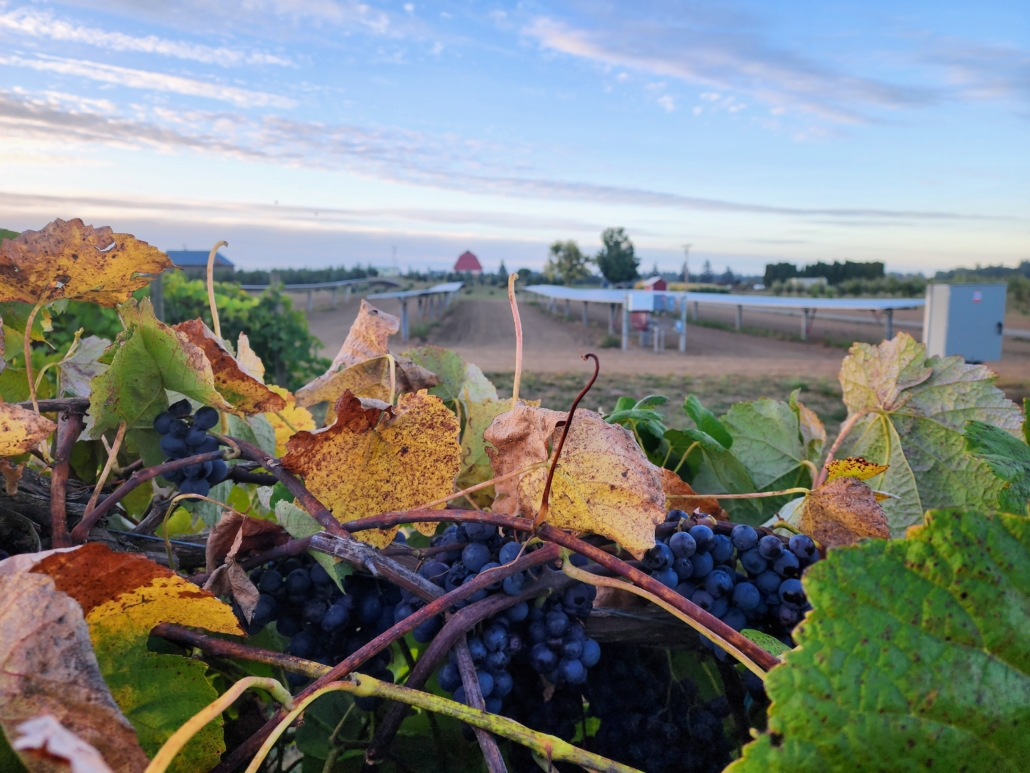
Vines growing among solar arrays. Photo: NCAT
By Brian Naughton, Co-Founder Circle Two, LLC. This article was first published in the NM Healthy Soil blog.
The sun provides abundant energy here in New Mexico, something I’ve appreciated professionally and personally since moving here ten years ago to work on renewable energy. The sun can also be a bit much at times as seen in my rather disappointing tomato patch this year. I’ve always enjoyed gardening as a hobby, but a few years ago I decided to step things up a bit by volunteering at the Rio Grande Community Farm located on the Los Poblanos Open Space in the North Valley of Albuquerque. I’ve learned so much from the community that gathers and works there about every aspect of growing food from soil health, irrigation methods, tools from small to big, and climate-controlled greenhouses to the changing climate of the open field.
One of my first days volunteering at the farm I noticed a stack of solar panels in the barn and began to brainstorm ways my renewable energy background and interest in growing food might work together. In the course of my research I came across the term agrisolar. Agrisolar, or agrivoltaics as it is sometimes called, is simply the co-location of solar power production with appropriate agricultural land use. This definition comes from the National Center for Appropriate Technology (NCAT), hosts of the AgriSolar Clearinghouse, a website for all stakeholders who are interested in finding trusted agrisolar information, funding sources, events, and more.
As I’ve learned, there are multiple potential benefits of pairing solar and agriculture. As interest in both renewable energy and sustainable agriculture grows, agrisolar has the potential to meet both needs. The benefits include producing food, conserving ecosystems, creating renewable energy, increasing pollinator habitat, and maximizing farm revenue. In our arid Southwest landscape, researchers at the University of Arizona have found the microenvironment among the solar panels can increase humidity, decrease daytime temperatures, and increase nighttime temperatures, all of which can increase the efficiency of crop production and solar electricity generation in a symbiotic relationship.
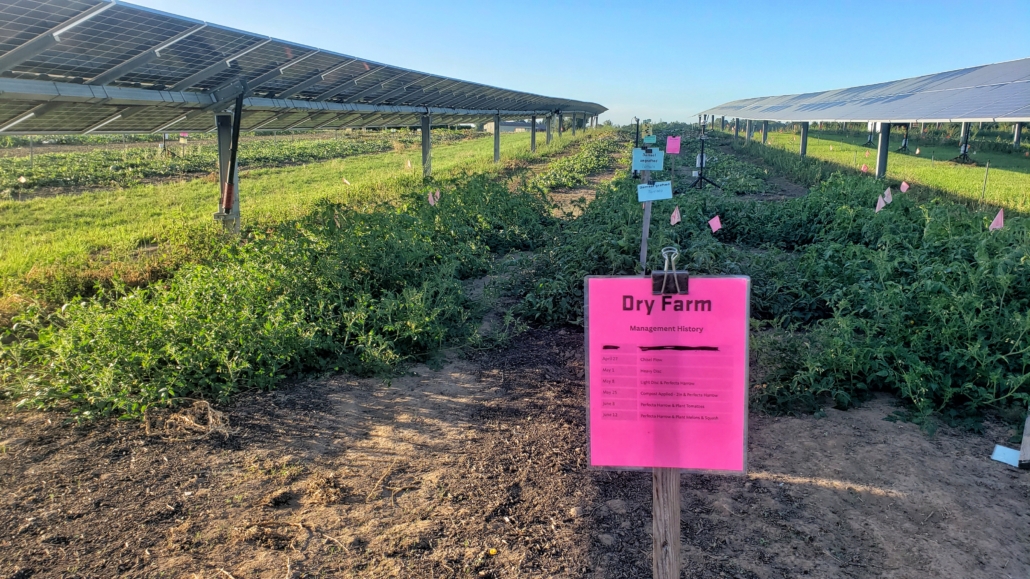
Tomatoes growing in an agrivoltaic setting. Photo: NCAT
I find the broader connections between energy and food quite interesting and important. Sunlight is the primary energy source that keeps our living ecosystem, and our human gizmos, moving. Plants absorb the daily flows of sunlight to convert carbon dioxide in the air into biomass above and below ground. Our human systems largely do the opposite, combusting stocks of solar energy in the form of fossil fuels in the ground and turning them into carbon dioxide in the air, with all the resulting impacts we’ve come to know too well. Our domesticated crops turn out, perhaps unsurprisingly, to be a bit of a mix of energy sources.
Researchers at the University of Michigan have compiled data from multiple sources to produce some eye-opening infographics on energy use in the US food system. The biggest takeaway for me is that on average it requires 14 times the energy inputs for each calorie we consume, and the majority of that input is still fossil fuels. Perhaps agrisolar projects can help shift that statistic towards something more sustainable, but there are some knowledge gaps about how best to deploy this technology.
Agrisolar in New Mexico
One of the six soil health principles promoted by New Mexico Healthy Soil and others is to know your context. This applies equally well to agrisolar projects and the need for location-specific knowledge. While some agrisolar knowledge and practice is universal, much of it is location-specific. Fortunately, there are a few nascent efforts in New Mexico beginning to explore agrisolar applications and develop best practices for our state. I’ve chosen a few to highlight that I’m aware of, but I’m sure there are many more people and organizations that are experimenting with this approach that I have not yet learned of.
New Mexico State University
Researchers at New Mexico State University just completed their first year investigating New Mexico green chile production under partial agrivoltaics shading at the Leyendecker Plant Science Research Center near Las Cruces. Drs. Marisa Thompson, Stephanie Walker, Olga Lavrova, and Israel Joukhadar lead the project that is supported by the New Mexico Department of Agriculture’s Specialty Crop Block Grant program. Mariela Estrada is a graduate student on the project helping to coordinate the field trial and gather data, which is currently being analyzed. The project is exploring the effects of integrating solar panels into vegetable production fields, with a particular focus on the impact on disease, plant growth, and overall yield. This innovative integration of technology into agricultural fields has the potential to offer dual benefit to New Mexico producers, protecting their crops from the region’s hot and arid climate while simultaneously generating additional income through renewable energy production. The researchers are considering additional crops they could study in the coming years.
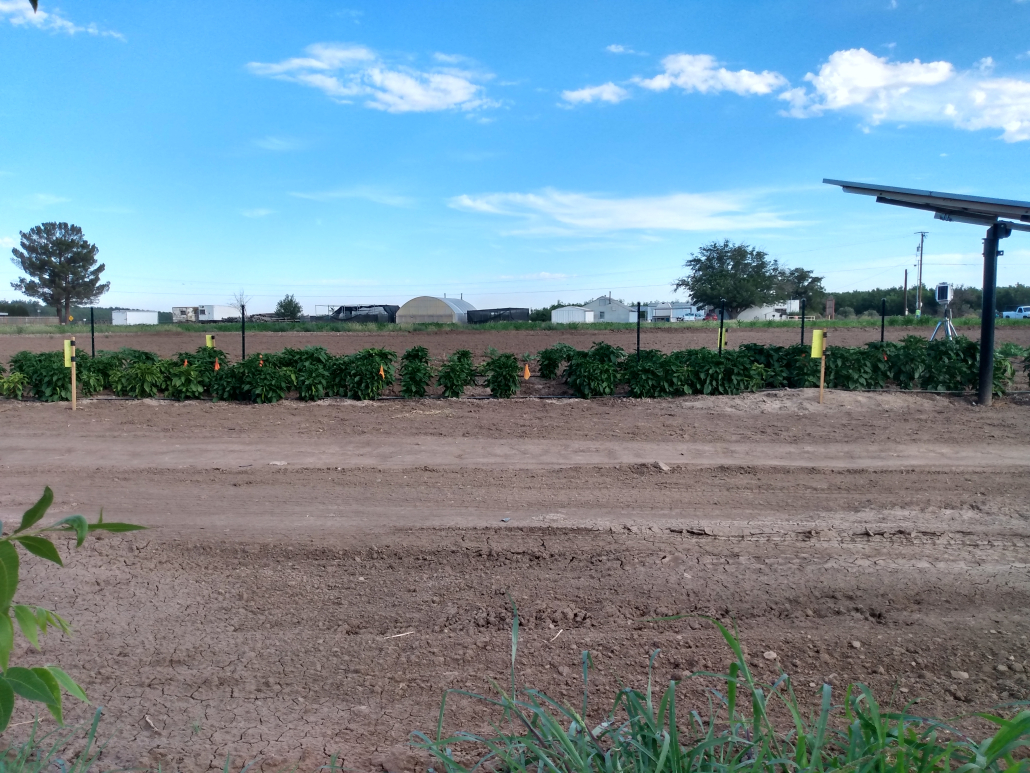
Chiles growing on an agrisolar research site at New Mexico State University. Photo: Israel Joukhadar
USDA Agricultural Research Service
Another agrivoltaics research project in the Las Cruces area is being led by the USDA’s Agricultural Research Service. Brandon Bestelmeyer from the Range Management Research location and Derek Whitelock from the Southwest Cotton Ginning Research Laboratory are collaborating on a project titled “Sustainable Multi-functional Agricultural and Energy Systems for Arid Environments.” The project aims to develop optimized agrivoltaic designs for rangeland, crops, and processing facilities and to build accompanying decision support tools including economic and life-cycle assessments so farmers and ranchers can make informed decisions about their operations. The project will be a highly collaborative effort engaging with multiple stakeholders. University partners will support experiments in photovoltaic installations exploring crop and soil types common to Southwestern ecosystems at agricultural research centers and postharvest processors. Government agencies and agricultural stakeholders managing land on which renewable energy is being developed are also envisioned as project partners. The project just kicked off in 2023 and will begin by defining knowledge gaps about potential agrivoltaic co-benefits and challenges to determine priorities for subsequent research in the region.
Los Alamos National Laboratory
One of the first agrivoltaics projects I learned about was in the El Rito area led by Los Alamos National Laboratory researcher Sanna Sevanto to support Trollworks, a biochar production equipment manufacturer located in Santa Clara, NM. Funded through the New Mexico Small Business Assistance Program, the researchers tested the effects of biochar on plant growth in an agrivoltaics setting at the solar installation located at Northern New Mexico College’s El Rito campus. Growth and productivity of tomato and Swiss chard was compared on plots where originally non-arable soil was amended to crop growth by incorporating compost and a compost-biochar mixture to the original soil under and next to the solar panels (see photo). The 1.5-megawatt solar installation itself was constructed in 2019 under a partnership between Northern New Mexico College, Kit Carson Electric Cooperative (KCEC), and Guzman Energy. The array helps to transition not only the college, but also the entire KCEC membership and communities west of the Rio Grande served by KCEC toward achieving 100% daytime solar power.
SunShare
Community solar offers a particularly exciting opportunity for agrivoltaics in New Mexico. Signed into law in 2021, the program administrator awarded the first 200 megawatts of capacity to multiple solar developers to construct projects up to 5 megawatts each that will offer subscriptions to customers of the three investor-owned utilities in the state. One of those developers is SunShare, a developer of community solar installations founded in 2011. In addition to providing workforce development opportunities, lease payments to local landowners, and electric bill discounts to low-income subscribers, SunShare will be working with New Mexico Healthy Soil Working Group to incorporate agrivoltaic design concepts into their New Mexico projects. SunShare already has some demonstrated experience with agrisolar on a project in Minnesota working with local farmers on vegetable production and an apiary located within the solar panel rows (see Minnesota Farm Guide: Agrivoltaics—Solar plus farm production is gaining ground).
Sandia National Laboratories
The final agrivoltaics project I’d like to highlight is from a diverse team led by Dr. Ken Armijo at Sandia National Laboratories with partners at SkySun, University of New Mexico, Jemez Mountain Electric Cooperative, Rio Grande Community Farm, and my own company, Circle Two. The project started this fall and will explore a novel solar technology developed by Skysun and Sandia over the next two years including laboratory testing at Sandia, field testing at Rio Grande Community Farm and assessing the commercial potential within the Jemez Mountain Electric Cooperative service area. The unique design of the photovoltaic system (see image) will allow improved crop cultivation access with tractors and personnel along with more efficient operations and maintenance over commercially available fixed-framed agrivoltaics installations. The agrivoltaics system will be connected to a battery storage and control system forming a microgrid to power on-site loads including an electric tractor and irrigation pumps. This project brings my agrivoltaics journey full circle starting with that stack of solar panels in the barn and now exploring the potential benefits of combining solar energy and crops in the field at the nearby fields at Rio Grande Community Farm.
Click here to view the original post and photos on the New Mexico Healthy Soil blog.
P

